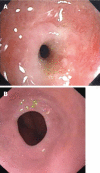Safety and outcome using endoscopic dilatation for benign esophageal stricture without fluoroscopy
- PMID: 22180849
- PMCID: PMC3240673
- DOI: 10.4292/wjgpt.v2.i6.46
Safety and outcome using endoscopic dilatation for benign esophageal stricture without fluoroscopy
Abstract
Aim: To investigate the use of Savary-Gilliard marked dilators in tight esophageal strictures without fluoroscopy.
Methods: Seventy-two patients with significant dysphagia from benign strictures due to a variety of causes were dilated endoscopically. Patients with achalasia, malignant lesions or external compression were excluded. The procedure consisted of two parts. First, a guide wire was placed through video endoscopy and then dilatation was performed without fluoroscopy. In general, "the rule of three" was followed. Effective treatment was defined as the ability of patients, with or without repeated dilatations, to maintain a solid or semisolid diet for more than 12 mo.
Results: Six hundred and sixty two dilatations in a total of 72 patients were carried out. The success rate for placement of a guide wire was 100% and for dilatation 97%, without use of fluoroscopy, after 6 mo to 4 years of follow-up. The number of sessions per patient was between 1 and 7, with an average of 2 sessions. The ability of patients, after 1 or more sessions of dilatation, to maintain a solid or semisolid diet for more than 12 mo was obtained in 70 patients (95.8%). For very tight esophageal strictures, all patients improved clinically without complications after the endoscopic procedure without fluoroscopy, but we noted 3 failures.
Conclusion: Dilatation using Savary-Gilliard dilators without fluoroscopy is safe and effective in the treatment of very tight esophageal strictures if performed with care.
Keywords: Dilatation; Esophageal benign strictures; Outcome; Results; Savary-Gilliard dilators.
Figures
Similar articles
-
Endoscopic dilation of esophageal stricture without fluoroscopy is safe and effective.World J Gastroenterol. 2002 Aug;8(4):766-8. doi: 10.3748/wjg.v8.i4.766. World J Gastroenterol. 2002. PMID: 12174394 Free PMC article.
-
Esophageal and pharyngeal strictures: report on 1,862 endoscopic dilatations using the Savary-Gilliard technique.Eur Arch Otorhinolaryngol. 2008 Mar;265(3):357-64. doi: 10.1007/s00405-007-0456-0. Epub 2007 Sep 26. Eur Arch Otorhinolaryngol. 2008. PMID: 17899143 Review.
-
Comparison between Savary-Gilliard and balloon dilatation of benign esophageal strictures.World J Surg. 1990 Jul-Aug;14(4):518-21; discussion 521-2. doi: 10.1007/BF01658680. World J Surg. 1990. PMID: 2382455 Clinical Trial.
-
Out-patient esophageal dilation: an experience in 130 patients using Savary-Gilliard dilators.Indian J Gastroenterol. 1992 Apr;11(2):65-7. Indian J Gastroenterol. 1992. PMID: 1428033
-
[Esophageal dilatation using the Savary-Gilliard sound set].Orv Hetil. 1992 Nov 15;133(46):2963-6. Orv Hetil. 1992. PMID: 1437120 Review. Hungarian.
Cited by
-
Efficacy and Safety of Endoscopic Esophageal Dilatation in Pediatric Patients with Esophageal Strictures.Int J Pediatr. 2021 Sep 24;2021:1277530. doi: 10.1155/2021/1277530. eCollection 2021. Int J Pediatr. 2021. PMID: 34608394 Free PMC article.
-
Evidence-based treatments for eosinophilic esophagitis: insights for the clinician.Therap Adv Gastroenterol. 2022 Jan 19;15:17562848211068665. doi: 10.1177/17562848211068665. eCollection 2022. Therap Adv Gastroenterol. 2022. PMID: 35069803 Free PMC article. Review.
-
Biodegradable Stents in Resistant Peptic Oesophageal Stricture: Is It the Right Way to Go?Clin Med Insights Gastroenterol. 2018 Dec 20;11:1179552218819492. doi: 10.1177/1179552218819492. eCollection 2018. Clin Med Insights Gastroenterol. 2018. PMID: 30627002 Free PMC article. Review.
-
Esophageal dilation through bouginage or balloon catheters in children, as the treatment of benign esophageal strictures: results, considering the etiology, and the methods.Ulus Travma Acil Cerrahi Derg. 2023 May;29(5):574-581. doi: 10.14744/tjtes.2022.03881. Ulus Travma Acil Cerrahi Derg. 2023. PMID: 37145049 Free PMC article.
References
-
- Siersema PD. Treatment options for esophageal strictures. Nat Clin Pract Gastroenterol Hepatol. 2008;5:142–152. - PubMed
-
- Cotton PB, Williams CP. Pratical gastrointestinal endoscopy. 3nd ed. Oxford: Blackwell Sci Pub; 1990. pp. 59–61.
-
- Geenen JE, Fleischer DE, Waye JD. Techniques in therapeutic endoscopy. 2nd ed. New York: Gower Med Pub; 1992. pp. 2: 9–11.
-
- Bennett JR, Hunt RH. Therapeutic endoscopy and radiology of the gut. 2nd ed. New York: Chapman and Hall Med; 1990. pp. 19–20.
LinkOut - more resources
Full Text Sources



